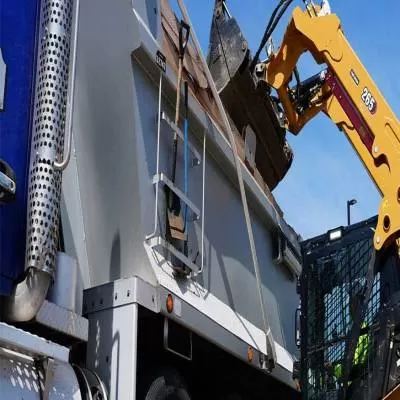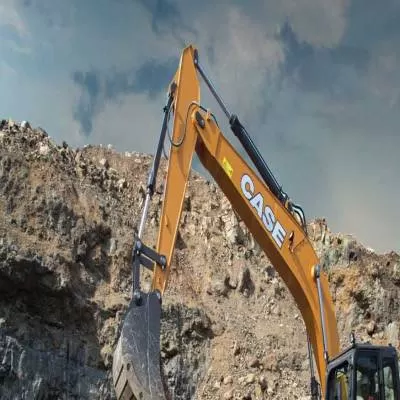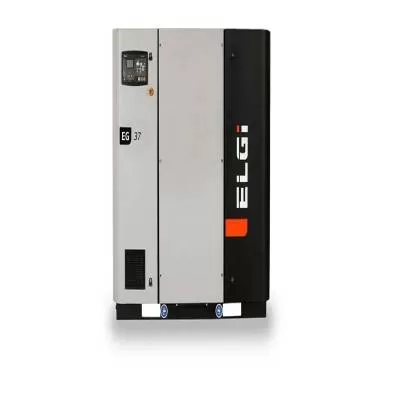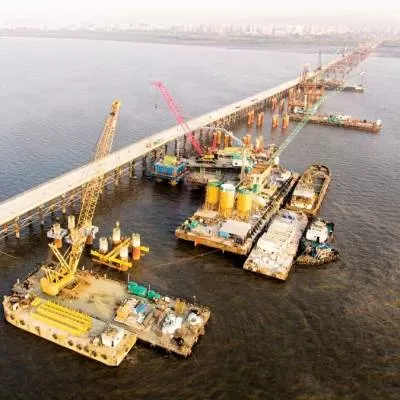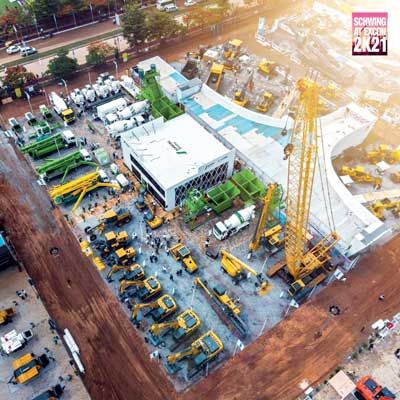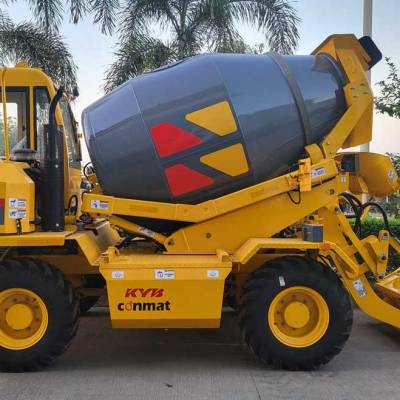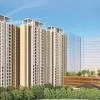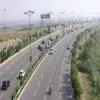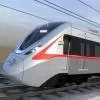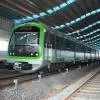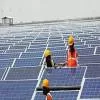Scaling New Heights
Today’s construction landscape is changing rapidly – and spectacularly. In this scenario, the scope for different kinds of equipment is inevitably growing. This includes tower cranes, which facilitate the construction of high-rise buildings, power plants and steel plants. While the slowdown in construction has somewhat subdued demand for tower cranes this year vis-à-vis last year, Rajesh Sharma, Vice President and Head-Marketing & Sales, Escorts Construction Equipment Ltd (ECEL), expects that the present slowdown should phase out in the next couple of quarters as major infrastructure projects get off the ground. “I expect the infrastructure sector’s demand for tower cranes to grow at around 10 to 15 per cent CAGR for the next five years,” he predicts.
Growing awareness is also bound to boost sales. According to Sanjay Vasudeo, Director, SN Mercantile India Pvt Ltd, a supplier of 6 metric tonne (mt) to 120 mt tower cranes imported from China, “Tower cranes are the best tool to facilitate vertical movement in the construction industry. They provide safer and faster construction. Their market potential is divided into three segments – 6 mt to 10 mt tower cranes used for building construction, 12 mt to 50 mt models used for industrial and heavy construction and the 80 mt to 120 mt segment used for power plant, steel plant and cement plant construction.” As things stand, Nitin Madankar, Director, SN Mercantile India Pvt Ltd estimates the overall nationwide annual demand for tower cranes in India at around 450 to 500 units. “This is expected to grow by about 20 per cent on the back of expansion in the real estate market and customer’s growing awareness of the benefit of tower cranes.”
Changing trends
In Sharma’s view, the current market size for tower cranes is around 300 units per annum. Of this, about 75 to 80 per cent is for tower cranes in the class of 5-6 tonne models. Demand is changing, albeit slowly. “It is likely to shift from lower to higher capacity tower cranes, of 12-18 tonne capacity,” he adds. “Technologically superior tower cranes, in terms of safety features and meeting overall quality standards, will be sought after for niche projects in the power, industrial and high-rise building sectors. Fewer users will opt for less expensive, lower-end cranes with dated technology and quality standards that presently dominate the market.”
In recent years, Zoomlion’s range of cranes has been very well accepted in the Indian market. “We have sold about 500 units since our launch in 2004 with our 6 tonne model being the most favoured,” shares Flander Fan, Regional Manager-North, Zoomlion Trade (India) Pvt Ltd. “About four-fifths of the tower crane market is for such low-capacity cranes. Delhi, Mumbai and Hyderabad are the key markets for these cranes.” The company sold six units of its TC7052-25 with 25 tonne lifting capacity model last year to Reliance Industries for the construction of a power plant. Inquiry trends suggest that larger capacity cranes may find more takers in the future. Further, Zoomlion is preparing to commission its first overseas tower crane manufacturing plant in India this year. “We have already confirmed our local partner and everything is going smoothly,” adds Fan.
For his part, Ashwani Mattoo, National Sales Manager for Potain tower cranes, Manitowoc Cranes India, expects more companies to take interest in the benefits of self-erecting cranes: speed, simplicity, smooth operations, and their ability to get into difficult spaces. “There is a huge amount of development taking place in India, and as job sites become tighter, contractors must be more creative in what cranes they send and where they put them when on site.”
Focal areas
As the market evolves, each company is reaching out to the Indian construction industry in different ways and their focus is becoming clear. “Terex is primarily focusing on the large tower crane segments that are mainly used in urban infra, power projects, airport construction, flyovers, etc, as we would like to partner companies who are focusing on jobs that need precision and safe working conditions,” shares Martin Seibert, Director-Sales & Services, Terex Cranes India, which offers self-erecting cranes (upto 4 tonne), flat top tower cranes (upto 40 tonne) and luffing cranes (upto 32 tonne).
Meanwhile, Manitowoc India is committed to helping Indian clients optimise their investments in machinery. To this end, it is manufacturing a wide range of cranes in India. “We manufacture several top-slewing tower cranes at our factory in Pune, of which the most popular is the Potain MCi 85A (5 tonne capacity),” says Mattoo. “Last year, we introduced a new tower crane, the MC 125, a 6 tonne capacity crane. Another popular crane, also made in India, is the MC 205 B, a 10 tonne capacity crane with a 60 m maximum jib and an ability to lift 2.4 tonne at the jib end.” Potain also markets special application, high-capacity tower cranes made at its factories outside India. These are used for infrastructure and large industrial projects. The most popular model in this range is the MD 1100, and it has been well accepted in India by Jaiprakash Associates Ltd, which owns the largest single fleet of these cranes in the world.
Manitowoc India is also actively helping clients use cranes innovatively. For instance, L&T owns 60 Potain tower cranes, including several MC 205 B cranes. It has converted six of these cranes to be able to climb floors to allow them to increase the working height of the cranes as building work progresses. Since then, India Bulls Real Estate is applying the cranes
in a similar fashion to construct some of the tallest towers in Mumbai: Sky Suites, a 75-storey tower using two MC 205 cranes; the Sky Forest, an 80-storey tower using four MC 205 tower cranes; and the Sky, a 65-storey tower using two MC 205 cranes.
For Sharma at ECEL, the sole authorised distributor in the Indian market for the Comansa range of tower cranes, it is heartening that takers are growing for Escorts flat top tower cranes and luffing jib tower cranes (up to 64 tonne), both of which are sourced from international plants in China and Spain. “L&T ECC, BGR Energy, Billimoria, Navyuga, etc, are procuring our tower cranes for various infrastructure and real-estate projects,” he reveals. “Clients are aware that our flat top tower crane (up to 24 tonne) sourced from the Comansa Jie plant in China is not to be confused with Chinese cranes. It costs about twice the amount of a Chinese model, as the company is a tie-up with the Spanish Comansa.”
Indeed, the growing dedication of tower crane vendors to the Indian market bodes well for the construction industry. Together, vendors and users will achieve their common aim: to reach higher.
Case Study 1
Self-erecting cranes make a mark
• Vendor: Manitowoc Cranes India
• Product: Igo 32, Potain self-erecting crane
• Capacity: 4 tonne capacity
• Client: Tricon Infra
• Project: Construction of a cinema on the roof of a shopping mall in Pune
• Features: Igo self-erecting cranes have a very small footprint and are quick and easy to assemble on site. This makes them ideal for speedy construction at sites where space is limited. They are also easy to move around, travelling on just a single truck. The Igo 32 has a maximum hook height of 22 m and can lift 1.1 tonne at its 30 m jib end.
• Clientspeak: “I would say, using a Potain crane for the first time is like driving a car with power steering for the first time,” says Brajesh Singh, Partner, Tricon Infra. “It is much smoother to operate, more convenient, uses less energy and helps us manoeuvre faster. If you want a top-of-the-line crane, you buy a Potain. You also get access to Manitowoc Crane Care and its excellent after-sales service. We know that any crane we buy from Manitowoc will arrive on time and as promised.” Tricon Infra also owns four MCi 85 A cranes and an MC 125 from Potain’s top-slewing range.
Case Study 2
Flat-top tower cranes spur power sector construction
• Vendor: Escorts Construction Equipment Ltd (ECEL)
• Product: Comansa JIE tower crane
• Capacity: 18 tonne capacity with a height of over 200 m
• Client: BGR Energy (also L&T ECC)
• Project: Construction of natural draft cooling tower (L&T’s thermal plant at Rajpura, Punjab and BGR Energy’s EPC contract for the Kalasindh super thermal power plant at Jhalawar, Rajasthan)
• Features: The cranes have been supplied with a unique aerial jib dismantling device that enables the self-dismantling of the jib section at a height of over 200 m. This is a very useful cost-saving feature as it allows a lower-capacity mobile crane to be deployed for the dismantling exercise instead of a heavier model and reduces dismantling time. Also, the Comansa range of tower cranes is modular, which enables different capacity cranes to be erected by interchanging the components of tower cranes like jib and tower sections directly or by using transition frames and thereby optimising the storage and versatility of the product. These tower cranes allow the jacking cage to be connected on any of the four sides on the tower and require fewer jacking operations as the mast is of a bigger size, i.e. 5.5 m, thereby assuring higher productivity.
• Clientspeak: “We have found Escorts Comansa flat-top tower cranes very useful for the construction of the natural draft cooling tower,” says Adinarayan Rao, AVP (Tall Structures), BGR Energy. “In a short span of 11 months, we have been able to achieve the construction of around 150 m. We are quite happy about the performance of these cranes and ECEL’s product support. The safety and productivity aspects of these cranes are extremely good.”
Case Study 3
Working safely at an operational airport
• Vendor: Terex Cranes India
• Product: Flat-top tower crane
• Capacity: 8 tonne and 10 tonne capacity
• Client: L&T (ECC Division)
• Project: Multilevel car park and ATC tower at Chhatrapati Shivaji Mumbai International Airport
• Features: The Terex tower cranes at Mumbai airport are being used to lift steel and concrete. They were installed about a year ago. The crane height is about 90 m and the jib of the crane is 35 m. These cranes are allowing work to continue smoothly and safely within an operational airport.
• Clientspeak: “We are very happy with the safety features of Terex tower cranes,” opines Udit Narayan Singh, Plant Manager, L&T ECC. “The safety of both operators and workmen on site has been kept in mind while designing the cranes. The overall structure of a Terex crane is very rigid and strong – this helps us plan operations better and the lifting capacity of structures and materials can be done safely. Another good feature of Terex tower cranes is that they can be easily dismantled and reassembled, making it easy for us to move them from place to place – resource utilisation for doing this is much lower than for other cranes.”
Case Study 4
Building fleets with cranes from one vendor
• Vendor: Zoomlion International Trading (HK) Co Ltd
• Product: Zoomlion Tower Crane
• Capacity: 6 tonne
• Client: JMC Projects India Ltd
• Project: Provident Welworth City, Bengaluru, of Provident Housing Ltd
• Features: Zoomlion has a complete tower crane line ranging from 4 tonne to 240 tonne, with the latter being the world’s largest tower crane designed to operate in different working conditions. Zoomlion’s tower cranes range has incorporated PLC control since the 1990s. The cranes also have an automatic hook rate converter, quick-release fastener, slewing mechanism with frequency altering and speed-regulated, trolley radius changing mechanism with frequency altering and speed regulation to guarantee safety and high efficiency. The features of the operating cabin reflect the ‘human-centred notion’ of Zoomlion’s designing.
• Clientspeak: “I prefer Zoomlion’s models,” says Samson Kumar G, Manager, Plant & Machinery, JMC Projects India Ltd. “Our fleet of tower cranes numbers 40 and none has suffered a breakdown since we began patronising Zoomlion in 2007. Apart from being workhorses, Zoomlion tower cranes offer excellent safety features, are easy and swift to setup and dismantle, and are very user-friendly. Junior level site workers can easily be trained to operate the crane. This has helped us build a comfort level with the company’s products. Zoomlion is one of the most affordable and easy to operate cranes in India.”
Case Study 5
Positive review of Chinese cranes
• Vendor: SN Mercantile India Pvt Ltd
• Product: Tower crane imported from China
• Capacity: 6 mt
• Client: BG Shirke Construction Technology Pvt Ltd
• Project: MHADA residential buildings in Mumbai
• Clientspeak: “SN Mercantile India Pvt Ltd has a rich experience of supplying and supporting over 500 tower cranes in the Indian market,” says CN Nandurdikar, General Manager-Construction Equipment & Machinery Division, BG Shirke Construction Technology Pvt Ltd. “Their tower cranes are sourced from China and are made of the right quality of steel, electrical and electronics components. They offer after-sales support. Put tog-ether, their products are on a par with European cranes, especially in terms of safety and user-friendly features. The good part is that high-end Chinese cranes are 20 to
30 per cent less expensive than their European counterparts.”
To share your views or experiences with tower cranes, write in at feedback@ASAPPmedia.com
Tower cranes are gradually playing an increasingly vital role in construction, thus enhancing the scope for higher capacity and technologically superior varieties, discovers Charu Bahri.Today’s construction landscape is changing rapidly – and spectacularly. In this scenario, the scope for different kinds of equipment is inevitably growing. This includes tower cranes, which facilitate the construction of high-rise buildings, power plants and steel plants. While the slowdown in construction has somewhat subdued demand for tower cranes this year vis-à-vis last year, Rajesh Sharma, Vice President and Head-Marketing & Sales, Escorts Construction Equipment Ltd (ECEL), expects that the present slowdown should phase out in the next couple of quarters as major infrastructure projects get off the ground. “I expect the infrastructure sector’s demand for tower cranes to grow at around 10 to 15 per cent CAGR for the next five years,” he predicts.Growing awareness is also bound to boost sales. According to Sanjay Vasudeo, Director, SN Mercantile India Pvt Ltd, a supplier of 6 metric tonne (mt) to 120 mt tower cranes imported from China, “Tower cranes are the best tool to facilitate vertical movement in the construction industry. They provide safer and faster construction. Their market potential is divided into three segments – 6 mt to 10 mt tower cranes used for building construction, 12 mt to 50 mt models used for industrial and heavy construction and the 80 mt to 120 mt segment used for power plant, steel plant and cement plant construction.” As things stand, Nitin Madankar, Director, SN Mercantile India Pvt Ltd estimates the overall nationwide annual demand for tower cranes in India at around 450 to 500 units. “This is expected to grow by about 20 per cent on the back of expansion in the real estate market and customer’s growing awareness of the benefit of tower cranes.”Changing trendsIn Sharma’s view, the current market size for tower cranes is around 300 units per annum. Of this, about 75 to 80 per cent is for tower cranes in the class of 5-6 tonne models. Demand is changing, albeit slowly. “It is likely to shift from lower to higher capacity tower cranes, of 12-18 tonne capacity,” he adds. “Technologically superior tower cranes, in terms of safety features and meeting overall quality standards, will be sought after for niche projects in the power, industrial and high-rise building sectors. Fewer users will opt for less expensive, lower-end cranes with dated technology and quality standards that presently dominate the market.”In recent years, Zoomlion’s range of cranes has been very well accepted in the Indian market. “We have sold about 500 units since our launch in 2004 with our 6 tonne model being the most favoured,” shares Flander Fan, Regional Manager-North, Zoomlion Trade (India) Pvt Ltd. “About four-fifths of the tower crane market is for such low-capacity cranes. Delhi, Mumbai and Hyderabad are the key markets for these cranes.” The company sold six units of its TC7052-25 with 25 tonne lifting capacity model last year to Reliance Industries for the construction of a power plant. Inquiry trends suggest that larger capacity cranes may find more takers in the future. Further, Zoomlion is preparing to commission its first overseas tower crane manufacturing plant in India this year. “We have already confirmed our local partner and everything is going smoothly,” adds Fan.For his part, Ashwani Mattoo, National Sales Manager for Potain tower cranes, Manitowoc Cranes India, expects more companies to take interest in the benefits of self-erecting cranes: speed, simplicity, smooth operations, and their ability to get into difficult spaces. “There is a huge amount of development taking place in India, and as job sites become tighter, contractors must be more creative in what cranes they send and where they put them when on site.”Focal areasAs the market evolves, each company is reaching out to the Indian construction industry in different ways and their focus is becoming clear. “Terex is primarily focusing on the large tower crane segments that are mainly used in urban infra, power projects, airport construction, flyovers, etc, as we would like to partner companies who are focusing on jobs that need precision and safe working conditions,” shares Martin Seibert, Director-Sales & Services, Terex Cranes India, which offers self-erecting cranes (upto 4 tonne), flat top tower cranes (upto 40 tonne) and luffing cranes (upto 32 tonne).Meanwhile, Manitowoc India is committed to helping Indian clients optimise their investments in machinery. To this end, it is manufacturing a wide range of cranes in India. “We manufacture several top-slewing tower cranes at our factory in Pune, of which the most popular is the Potain MCi 85A (5 tonne capacity),” says Mattoo. “Last year, we introduced a new tower crane, the MC 125, a 6 tonne capacity crane. Another popular crane, also made in India, is the MC 205 B, a 10 tonne capacity crane with a 60 m maximum jib and an ability to lift 2.4 tonne at the jib end.” Potain also markets special application, high-capacity tower cranes made at its factories outside India. These are used for infrastructure and large industrial projects. The most popular model in this range is the MD 1100, and it has been well accepted in India by Jaiprakash Associates Ltd, which owns the largest single fleet of these cranes in the world.Manitowoc India is also actively helping clients use cranes innovatively. For instance, L&T owns 60 Potain tower cranes, including several MC 205 B cranes. It has converted six of these cranes to be able to climb floors to allow them to increase the working height of the cranes as building work progresses. Since then, India Bulls Real Estate is applying the cranes in a similar fashion to construct some of the tallest towers in Mumbai: Sky Suites, a 75-storey tower using two MC 205 cranes; the Sky Forest, an 80-storey tower using four MC 205 tower cranes; and the Sky, a 65-storey tower using two MC 205 cranes.For Sharma at ECEL, the sole authorised distributor in the Indian market for the Comansa range of tower cranes, it is heartening that takers are growing for Escorts flat top tower cranes and luffing jib tower cranes (up to 64 tonne), both of which are sourced from international plants in China and Spain. “L&T ECC, BGR Energy, Billimoria, Navyuga, etc, are procuring our tower cranes for various infrastructure and real-estate projects,” he reveals. “Clients are aware that our flat top tower crane (up to 24 tonne) sourced from the Comansa Jie plant in China is not to be confused with Chinese cranes. It costs about twice the amount of a Chinese model, as the company is a tie-up with the Spanish Comansa.”Indeed, the growing dedication of tower crane vendors to the Indian market bodes well for the construction industry. Together, vendors and users will achieve their common aim: to reach higher.Case Study 1Self-erecting cranes make a mark• Vendor: Manitowoc Cranes India • Product: Igo 32, Potain self-erecting crane • Capacity: 4 tonne capacity • Client: Tricon Infra • Project: Construction of a cinema on the roof of a shopping mall in Pune• Features: Igo self-erecting cranes have a very small footprint and are quick and easy to assemble on site. This makes them ideal for speedy construction at sites where space is limited. They are also easy to move around, travelling on just a single truck. The Igo 32 has a maximum hook height of 22 m and can lift 1.1 tonne at its 30 m jib end. • Clientspeak: “I would say, using a Potain crane for the first time is like driving a car with power steering for the first time,” says Brajesh Singh, Partner, Tricon Infra. “It is much smoother to operate, more convenient, uses less energy and helps us manoeuvre faster. If you want a top-of-the-line crane, you buy a Potain. You also get access to Manitowoc Crane Care and its excellent after-sales service. We know that any crane we buy from Manitowoc will arrive on time and as promised.” Tricon Infra also owns four MCi 85 A cranes and an MC 125 from Potain’s top-slewing range.Case Study 2Flat-top tower cranes spur power sector construction• Vendor: Escorts Construction Equipment Ltd (ECEL)• Product: Comansa JIE tower crane• Capacity: 18 tonne capacity with a height of over 200 m• Client: BGR Energy (also L&T ECC)• Project: Construction of natural draft cooling tower (L&T’s thermal plant at Rajpura, Punjab and BGR Energy’s EPC contract for the Kalasindh super thermal power plant at Jhalawar, Rajasthan)• Features: The cranes have been supplied with a unique aerial jib dismantling device that enables the self-dismantling of the jib section at a height of over 200 m. This is a very useful cost-saving feature as it allows a lower-capacity mobile crane to be deployed for the dismantling exercise instead of a heavier model and reduces dismantling time. Also, the Comansa range of tower cranes is modular, which enables different capacity cranes to be erected by interchanging the components of tower cranes like jib and tower sections directly or by using transition frames and thereby optimising the storage and versatility of the product. These tower cranes allow the jacking cage to be connected on any of the four sides on the tower and require fewer jacking operations as the mast is of a bigger size, i.e. 5.5 m, thereby assuring higher productivity.• Clientspeak: “We have found Escorts Comansa flat-top tower cranes very useful for the construction of the natural draft cooling tower,” says Adinarayan Rao, AVP (Tall Structures), BGR Energy. “In a short span of 11 months, we have been able to achieve the construction of around 150 m. We are quite happy about the performance of these cranes and ECEL’s product support. The safety and productivity aspects of these cranes are extremely good.”Case Study 3Working safely at an operational airport• Vendor: Terex Cranes India• Product: Flat-top tower crane• Capacity: 8 tonne and 10 tonne capacity• Client: L&T (ECC Division)• Project: Multilevel car park and ATC tower at Chhatrapati Shivaji Mumbai International Airport• Features: The Terex tower cranes at Mumbai airport are being used to lift steel and concrete. They were installed about a year ago. The crane height is about 90 m and the jib of the crane is 35 m. These cranes are allowing work to continue smoothly and safely within an operational airport. • Clientspeak: “We are very happy with the safety features of Terex tower cranes,” opines Udit Narayan Singh, Plant Manager, L&T ECC. “The safety of both operators and workmen on site has been kept in mind while designing the cranes. The overall structure of a Terex crane is very rigid and strong – this helps us plan operations better and the lifting capacity of structures and materials can be done safely. Another good feature of Terex tower cranes is that they can be easily dismantled and reassembled, making it easy for us to move them from place to place – resource utilisation for doing this is much lower than for other cranes.”Case Study 4Building fleets with cranes from one vendor• Vendor: Zoomlion International Trading (HK) Co Ltd• Product: Zoomlion Tower Crane• Capacity: 6 tonne• Client: JMC Projects India Ltd• Project: Provident Welworth City, Bengaluru, of Provident Housing Ltd• Features: Zoomlion has a complete tower crane line ranging from 4 tonne to 240 tonne, with the latter being the world’s largest tower crane designed to operate in different working conditions. Zoomlion’s tower cranes range has incorporated PLC control since the 1990s. The cranes also have an automatic hook rate converter, quick-release fastener, slewing mechanism with frequency altering and speed-regulated, trolley radius changing mechanism with frequency altering and speed regulation to guarantee safety and high efficiency. The features of the operating cabin reflect the ‘human-centred notion’ of Zoomlion’s designing.• Clientspeak: “I prefer Zoomlion’s models,” says Samson Kumar G, Manager, Plant & Machinery, JMC Projects India Ltd. “Our fleet of tower cranes numbers 40 and none has suffered a breakdown since we began patronising Zoomlion in 2007. Apart from being workhorses, Zoomlion tower cranes offer excellent safety features, are easy and swift to setup and dismantle, and are very user-friendly. Junior level site workers can easily be trained to operate the crane. This has helped us build a comfort level with the company’s products. Zoomlion is one of the most affordable and easy to operate cranes in India.”Case Study 5Positive review of Chinese cranes• Vendor: SN Mercantile India Pvt Ltd• Product: Tower crane imported from China• Capacity: 6 mt• Client: BG Shirke Construction Technology Pvt Ltd• Project: MHADA residential buildings in Mumbai• Clientspeak: “SN Mercantile India Pvt Ltd has a rich experience of supplying and supporting over 500 tower cranes in the Indian market,” says CN Nandurdikar, General Manager-Construction Equipment & Machinery Division, BG Shirke Construction Technology Pvt Ltd. “Their tower cranes are sourced from China and are made of the right quality of steel, electrical and electronics components. They offer after-sales support. Put tog-ether, their products are on a par with European cranes, especially in terms of safety and user-friendly features. The good part is that high-end Chinese cranes are 20 to 30 per cent less expensive than their European counterparts.”To share your views or experiences with tower cranes, write in at feedback@ASAPPmedia.com


